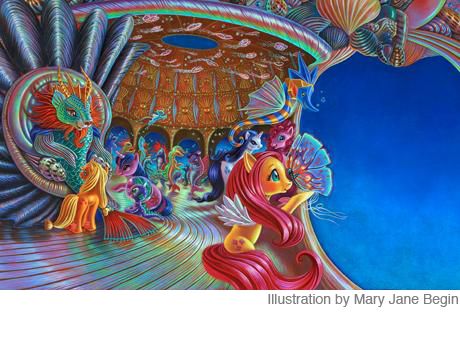March
________________________________________________________________________________________________________________________________________
Behind the Book takes an in depth look at the world of the book through articles and interviews about the creative process, issues in publishing, and the writing life.
________________________________________________________________________________________________________________________________________
Telling Stories Through Art
Acclaimed illustrator and author Mary Jane Begin shares her artistic journey – and tips for visual storytelling – in the Mary Tefft White Cultural Center Talking in the Library Series
Teaser: From creating characters to framing a scene, Mary Jane Begin reveals her dos and don’ts for crafting great visual stories
By Leah Catania ’14

BRISTOL, R.I. – With the advancements of high-resolution cameras that capture vivid color saturation on high-definition digital screens, technology makes it effortless to view the vibrant colors of the world. But it’s still valuable to recognize that color shapes the way we interpret our surroundings and – consciously or not – imbue it with meaning. For Mary Jane Begin, a celebrated children's illustrator and faculty member at the Rhode Island School of Design, color consumes her life – as a child she relished creating dazzling hues, a passion that later catapulted her to award-winning author and illustrator of acclaimed children’s books.
True to RWU’s ongoing writer’s forum, Begin – vivaciously attired in a bright turquoise shirt and an iridescent purple and pink scarf – told her personal story, peppered with advice for burgeoning illustrators, at the Mary Tefft White Cultural Center: Talking in the Library Series on February 25. Begin, a professor of visual art at Rhode Island School of Design, has 10 children’s books under her belt, including a new edition of Kenneth Grahame’s classic tale, “The Wind in the Willows,” with 30 of her full-color illustrations. She is also known for writing and illustrating her own spinoffs on Grahame’s timeless children’s story and most recently a collaboration with Hasbro, “My Little Pony: Under the Sparkling Sea.”

Here, Begin reveals her dos and don’ts for aspiring storytellers based on her own creative journey:
- Don’t just draw a picture – tell a story, she advises. After Begin completed a college assignment illustrating the letter “Z” with a zebra, her professor told her that it didn’t say enough – she wanted to be told a story through the image. Emulating the way zebras’ stripes appear painted on, Begin depicted the zebra as the artist. But she created more than just a picture: her zebra had personality, as well as action and a motivation.
- Do observe the world carefully in order to re-create it well. As she learned from one particular art assignment, artists who don’t study their subject may be obliged to have the following exchange with the professor: ‘No, you didn't think to look at an actual boy’; and, ‘Yes, in your painting, his head does look like a cowbell.’
- Do layer your stories with meaning, even in children’s tales. On the cover of “The Porcupine Mouse,” young readers easily understand that one mouse is messy and the other is neat, but placing one mouse in shadow and one mouse in sunlight subconsciously conveys the idea that these two mice are like yin and yang – opposites that complete each other through their friendship.
- Do dally with details. Good visual stories are all about the details, Begin says. Link your characters and scenes together graphically so readers can “follow the bouncing ball” from page to page. The author should ask herself, ‘Does the character change his appearance every page?’ Keep a key detail and reference it – the blue and white stripes on the boy’s pajamas, or that his loyal dog gambols around in the background of every scene.
- Don’t leave it to guess work. If you’re having trouble drawing accurate proportions or dimensions, find a model you can study in detail, Begin says. Luckily for her, when she was working on “The Sorcerer’s Apprentice,” her daughter was the right size and age for the young girl in the story, serving as the perfect model when Begin was having trouble visualizing certain scenes.
- Do use size, shape and perspective to keep serene stories interesting, even when there’s very little action. Drawing a close-up of a mouse held in a bear’s paw resonates with children who see everything around them as large and imposing, she suggests.
- Do base your character on people you know, even when the characters are animals! For Begin, a bear wearing a flannel shirt might be based on her stepfather, while the traits of a goldilocks mouse might originate from her personality.
- Do save yourself time, trouble and expense by making photocopies on your own art-quality paper once your final sketches are complete – but beware of paper jams!
- Do break up the monotony of compositions created for certain page sizes by placing frames around the illustrations, she says. Sometimes scenes feel too boxed in and would benefit from bleeding off the page (publications-speak for having the image extend to the edge of the page). At other times start out with a frame, and then slowly break through the border. In “The Sorcerer’s Apprentice,” Begin pops a bucket out of the frame when the apprentice starts losing control, until everything is in complete chaos and water spills out of the frame to bleed off the page.
- Don’t forget, colors tell a story, too. Begin says that changing the color palette alters the emotional content. One of Begin’s favorite palettes is the pearly iridescence she used in “My Little Pony: Under the Sparkling Sea.” She tapped the shimmering colors of the sea, such as the inner side of an abalone seashell, to bring out the essence of being underwater.
Mary Jane Begin Gives Her Incite from Rwu Library on Vimeo.
________________________________________________________________________________________________________________________________________
Connect with the RWU Library on Facebook and Twitter!


